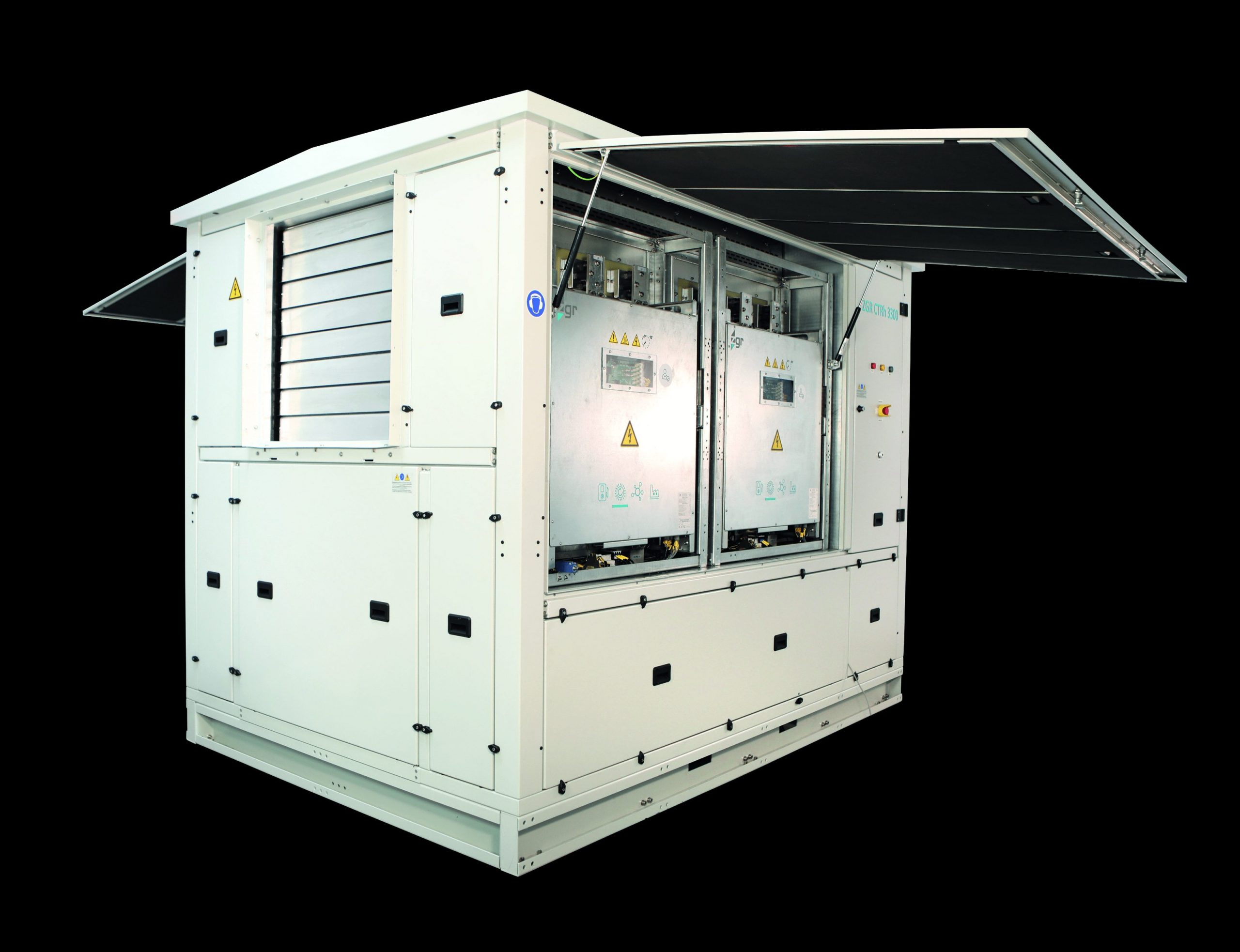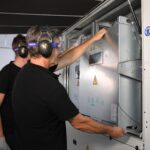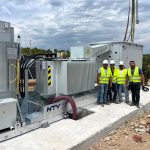Spain, storage take off with force
Spain has set itself an ambitious and necessary target to achive 81% renewable penetration by 2030: to reach22.5 GW of storage capacity for that date.
At the beginning of the year, progress seems to be promising, with 18 GW already awarded to independent batteries projects («stand alone») and the other in evaluation process.
The path is not free of obstacles. Regulatory challenges, administrative barriers and grid access limitations demand an accelerated evolution towards smart and distributed power grids.
Europe will increase sixfold its installed storage capacity
Growth winds are blowing in Europe too. In this regard, The European Energy Storage Association (EASE) projects an exponential growth, estimating that installed capacity will increase six-fold before 2030.
Even more optimistic, SolarPower Europe forecasts total battery storage capacity will reach 260 GWh by 2028 in Europe; i.e. a sevenfold increase over current levels.
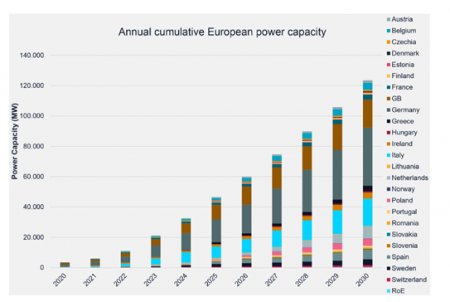
Fuente: EASE. Monitor Europeo del Mercado de Almacenamiento de Energía (EMMES), datos de marzo 2024. | EASE. European Energy Storage Market Monitor (EMMES), data for March 2024.
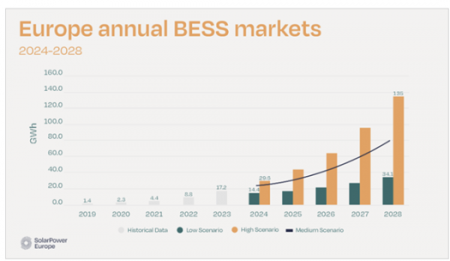
Fuente: Solar Power Europe, gráfico obtenido a través de su difusión en SmartGridInfo. | Solar Power Europe, graph obtained through its dissemination on SmartGridInfo.
These projections are reinforced by the analysis of the international Energy Agency (IEA), which projects global electricity demand for 2035 to be 6% higher that it predicted in 2023. The world is expected to add the equivalent of the annual electricity needs of more than 900 TW (terawatts) each year. And it emphasizes the importance of investment in storage and distributed electricity grids, as key pillars to promote the energy transition.
How will the cost of storage be paid for? Hybridization and capacity market
If we need storage to integrate more renewable generation, logic tells us that it will be the renewable generators that will promote integration of storage in their plants, and, to do so, it will have to be prioritized, in the procedures, to hybridized renewable plants.
However, if the storage is networked, needs capacity payments because it is not able to directly monetize the benefits it brings to the electricity system. This explains the importance of good implementing capacity market and studied all options, in order to limit the increase in the price of electricity for the end consumer, as well as to ensure the necessary infrastructures to connect and integrate it into the system.
The Capacity market: A significant change
Implementation of the capacity market in Spain will set a milestone in 2025, with the first bidding expected for the first semester for the MITECO. This mechanism, approved in December 2023 and develop in 2024, seeks to guarantee the power supply security, remunerating firm power availability.
Structure, based on competitive auction and payments for guarantee capacity, especially encourage energy storage. The system provides stability and security to investments, reducing risk and complementing income from the daily market. A successful implementation will help reduce volatility prices and enable the entry to technology storage in the energy mix.
Falling battery cost, What will be its impact on the market?
Another topic that we would like to highlight in this market analysis has to do with cost reduction in lithium-ion batteries, which is generating and significant impact in the storage market.
Lithium-ion Batteries cost has been reduced by about 80% in the last decade, making large scale storage projects increasingly viable, broadening the range of companies and regions that demand them.
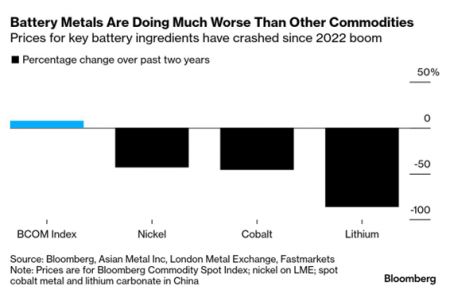
Evolución del precio de los metales. Fuente: Bloomberg | Metal Price evolution. Source: Bloomberg
This is particularly in photovoltaic projects, because incorporating storage equipment at competitive prices is managing to solve the intermittent problem and increase the use of the energy generated.
Goldman Sachs and others are projecting a continuation in the lithium battery price reduction, even talking about 50% drops by 2025-2026.
Price reduction will be an accelerator of the inclusion of storage in energetic projects residential and industrial. Some studies point that by 2025, 40% of new residential solar facilities will include storage energy in batteries.
If Battery prices continue falling in 2025, is possible that is not only due to lithium prices. (the mining industry is already at its limits), but to an increase in technological advances.
Technological development and innovation,towards diversification of technologies
The energy storage technology landscape is undergoing an unprecedented transformation.
Although lithium-ion Batteries will maintain its dominant position, 2025 will see the irruption of promising alternative technologies. Among others, we Will see redox Flow Batteries, that stand out for their storage capacity a large scale and its reduced degradation, and sodium-ion batteries, as more economical alternative.
The integration of artificial intelligence in battery management systems (BMS) will mark a before and an after. These systems will learn and optimize usage patterns in real time, allowing a more accurate prediction of battery service life, optimization of loading and unloading cycles and automatic automation of consumption patterns, among other processes, not to mention the development of predictive maintenance of equipment.
AI integration in battery management systems will come in 2025
We also believe that long term storage technologies (LDES) will experience significant development, responding to the critical need to manage the intermittency of renewables. In this regard, although the PNIEC sets out the GW targets achievable by 2030, we believe that the GWh should also be specified, because the main needs are long-term storage.
Downsizing and improved energy efficiency will be other key areas of innovation. Manufacturers are developing more compact and efficient designs, specially oriented to residential market, industrial and commercial.
In these markets, we will see state-of-the-art materials incorporated into the equipment to improve energy density, more efficient cooling systems and modular designs for easy installation and maintenance.
Long term storage technologies, equipment downsizing and improved energy efficiency, in the spotlight of manufacturers.
Integration of the Internet of Things (IoT) will revolutionize the monitoring and control of storage systems. Advaced sensors will primarily allowed automated management of the storage network, improving performance base on failures and early detection of potential failures.
Sustainability and Second Life of equipment, advances in circularity
Recycling and second life of batteries will undergo a significant transformation. New technologies will recover up to 84.5% lithium and 60.2% cobalt from used batteries. Companies like Naturgy and Mercedes-Benz, for example, are pioneering and are implementing storage systems with reused electric vehicle batteries, creating installations of up to 12 MW.
Companies like Apple have already announced the goal of using 100% recycled cobalt, while the European industry is developing infrastructure to recycle almost half of the battery capacity. These projects not only represent a sustainable solution, however create a new economic opportunities in the transition to a circular economy in the energy sector and the development of the recycling industry.
Cibersecurity, new challenge
In 2025 and beyond, storage technologies manufacturers in batteries will bet for two key cybersecurity trends: The integration of invisible ambient intelligence to improve device safety and traceability, and system development against disinformation, to keep the integrity of performance data and battery condition.
These arrangements reflect the growing importance of cybersecurity in the area, as batteries become critical components of the energy and transportation infrastructure.
In ZGR Corporation, we will continue to be at the forefront of the most innovative battery storage solutions in 2025, as for hybridization with photovoltaic projects, wind power, industrial and stand-alone projects in electrical distribution networks. Our best to offer the most flexible solutions, robust and market highly productive for the integrated management of electrical energy will continue producing equipment that is highly valued in the market, such as new ZGR PCS 3300, and the novelty of launching this year the ZGR PCS 4500, once again anticipating and providing solutions to the requirements of the sector.
If you have an energy storage project, give us a call and tell us about it.
Tu energía, nuestro reto.
Si quieres estar al día de nuestra actividad, puedes suscribirte a nuestro newsletter y sumarte a nuestra Comunidad en LinkedIn.
